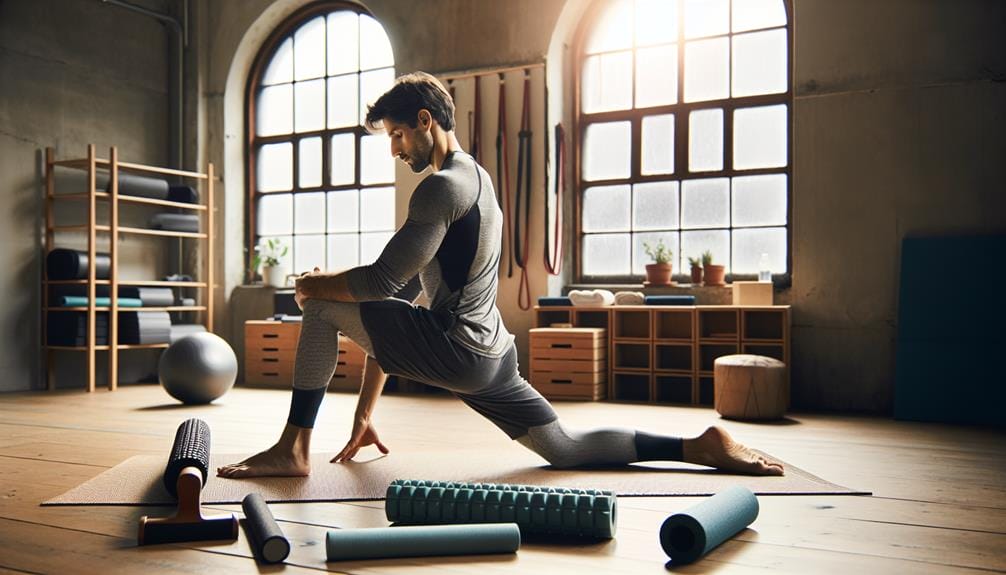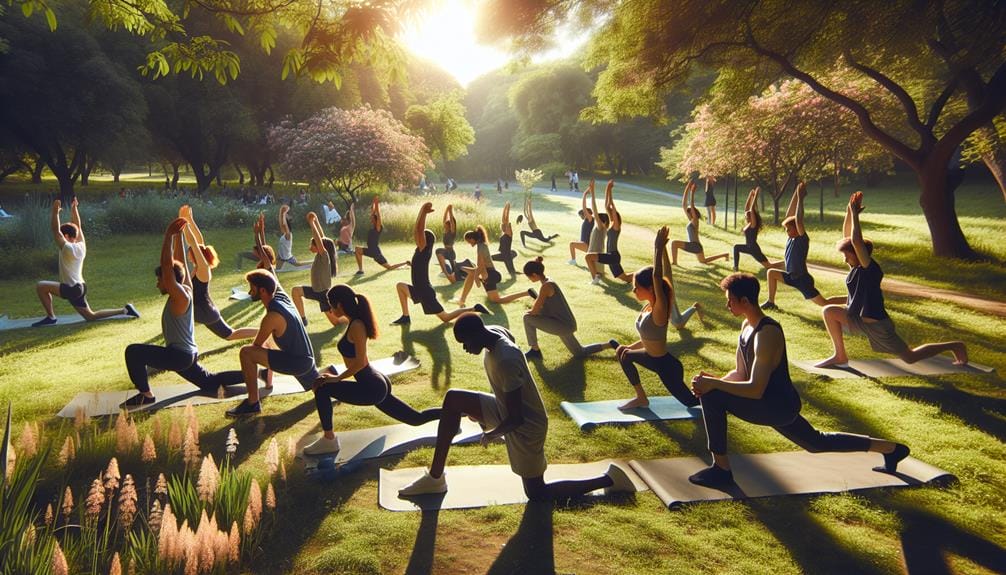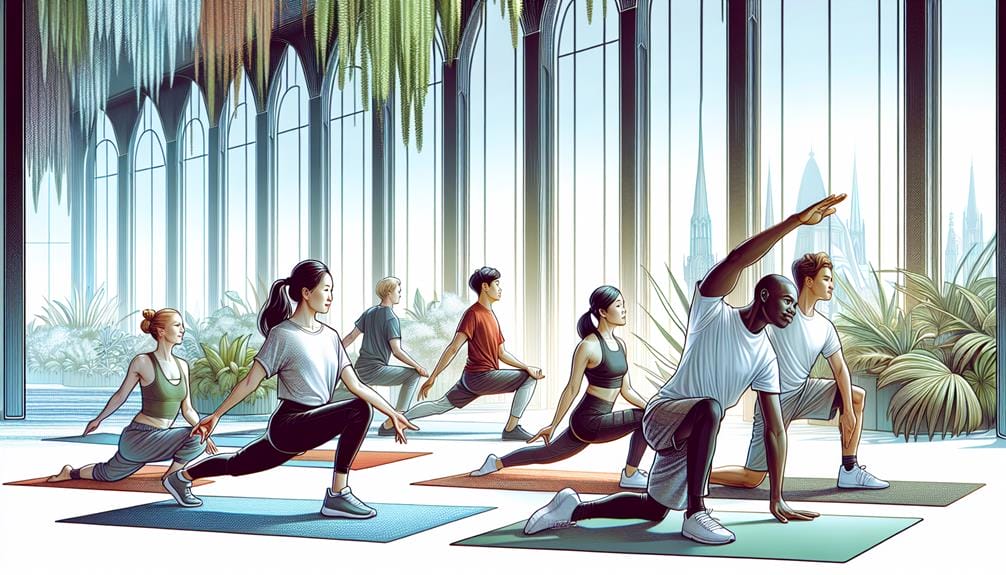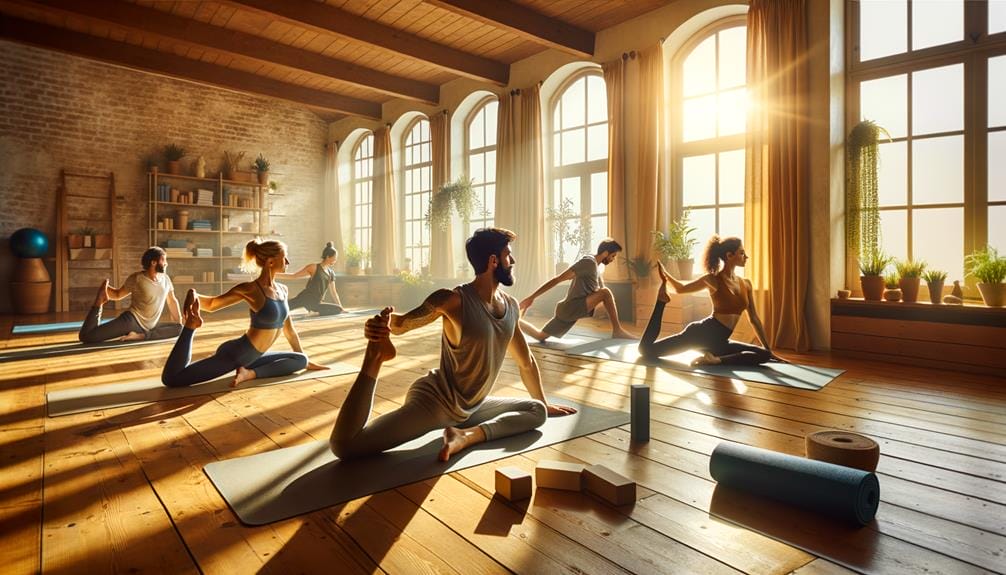Incorporating stretching exercises into your routine is vital for improving flexibility and enhancing your range of motion. Start with a warm-up using light cardio to prepare your muscles. Include both dynamic stretches, like leg swings, and static stretches, such as hamstring stretches, each held for 15-30 seconds. Focus on stretching all major muscle groups, from shoulders to calves. Proper breathing and avoiding bouncing are essential for effectiveness. Consistent practice not only reduces muscle tension but also prevents injuries and improves posture. To discover a complete guide on effective stretching routines and tips, continue exploring further.
Key Takeaways
- Dynamic stretching before workouts enhances flexibility and prepares muscles for exercise.
- Static stretching post-workout promotes muscle relaxation and improves range of motion.
- Focus on major muscle groups including shoulders, hamstrings, and hip flexors.
- Hold each static stretch for 15-30 seconds to maximize flexibility benefits.
- Consistent stretching routines reduce muscle tension and prevent injuries.
Benefits of Stretching
Incorporating stretching into your daily routine boosts flexibility, enhances posture, and improves overall muscle coordination. Think of it as giving your muscles a wake-up call.
Regular stretching helps improve your range of motion, making those yoga poses just a bit less torturous. You'll reduce muscle tension and give your joints a break, which is great news if you're into any physical activity.
The benefits of stretching are like a superhero team for your body: better balance, superior muscle coordination, and even improved blood circulation. Plus, you get to avoid the dreaded muscle soreness.
Stretching Essentials

Before you start stretching, it's essential to warm up your muscles with light cardio, like jogging or jumping jacks, to prevent injuries.
Focus on using both dynamic stretching to increase range of motion and static stretching to improve muscle elasticity.
Remember to stretch all major muscle groups, hold each stretch for at least 30 seconds, and avoid bouncing to guarantee effective and safe stretching.
Proper Warm-Up Techniques
To effectively prepare your body for stretching, start with light aerobic activities to boost blood flow and raise your body temperature. Think of it as waking up your muscles with a gentle nudge rather than a vital alarm clock.
Incorporate dynamic stretching, like leg swings or arm circles, to enhance joint flexibility and improve your range of motion. These warm-up techniques aren't just for show—they're essential to muscle performance and reducing the risk of injuries.
A proper warm-up can improve flexibility and prevent muscle strain, making your static stretching more effective. So, skip the nap and give your body the warm-up it deserves. Your muscles will thank you, and you'll be less likely to pull a hammy!
Key Stretching Tips
Now that you've warmed up properly, let's explore some key tips to make your stretching routine both safe and effective.
First, kick things off with dynamic stretches to boost flexibility and mobility. Save static stretches for post-workout to improve flexibility and ease muscle tension. Hold each stretch for 15-30 seconds—no bouncing, please! It reduces your risk for injury.
Consistency in stretching is your best friend; stick with it. Proper breathing will help relax those muscles and enhance your range of motion. Listen to your body—if something feels like a medieval torture device, ease up!
These stretching techniques will help you stay limber and ready to tackle whatever life throws at you. Happy stretching!
Dynamic Vs. Static Stretches
Understanding the differences between dynamic and static stretches is essential for optimizing your flexibility and performance.
Think of dynamic stretches as the vital warm-up act, moving your muscles and joints through a full range of motion to improve flexibility and muscle performance. They're perfect for prepping your body before a workout, helping you avoid that awkward first-step stumble.
Static stretches, on the other hand, are the vital, post-show cooldown. By holding a position, you target specific muscles and joints, promoting muscle relaxation and boosting your overall flexibility.
Both types are vital in a solid flexibility training routine, ensuring you can bend, twist, and reach without pulling a muscle or resembling a stiff board.
Stretches for Upper Body

Now, let's explore some key stretches for the upper body.
You'll benefit from shoulder stretches, neck flexibility moves, and arm stretch routines to improve your posture and reduce tension.
These exercises will help enhance your overall range of motion and keep your upper body flexible and strong.
Shoulder Stretch Techniques
Incorporating shoulder stretch techniques into your routine can greatly enhance upper body flexibility and reduce tension. Imagine your deltoids, trapezius, and rotator cuff muscles feeling like they've just had a spa day.
Shoulder stretches like shoulder rolls, cross-body arm stretches, and overhead shoulder stretches can improve your range of motion and flexibility. Plus, they work wonders for your posture and help reduce the risk of shoulder injuries.
Picture yourself reaching for that top shelf without grimacing—sounds nice, right? Regularly engaging in these stretches can transform your upper body into a well-oiled machine.
Neck Flexibility Moves
To boost your upper body flexibility and alleviate neck tension, try incorporating neck stretches like side bends and rotations into your routine.
Imagine you're trying to listen to an invisible conversation on your shoulder—side bends help target those stubborn muscle groups.
Meanwhile, rotations can make you feel like an owl, minus the 360-degree creepiness, enhancing your range of motion and posture.
Regular neck stretches can reduce neck pain and improve overall upper body mobility.
Plus, they're great for reducing tension that builds up from staring at screens all day.
Arm Stretch Routines
After giving your neck the attention it deserves, it's time to focus on arm stretches to enhance your upper body flexibility and reduce stiffness. By targeting your shoulders, triceps, and chest muscles, these stretches will improve your range of motion and help you prevent injuries. Plus, you'll look less like a robot and more like a graceful human.
Here are some essential arm stretches to try:
- Overhead Tricep Stretch: Raise your arm, bend at the elbow, and gently pull with the opposite hand.
- Cross-Body Shoulder Stretch: Bring one arm across your chest and use the other hand to pull it closer.
- Chest Opener: Clasp your hands behind your back and gently lift your arms.
- Bicep Stretch: Place your hand against a wall and turn your body away.
Incorporate these into your routine to improve posture and muscle function!
Stretches for Lower Body

When you stretch your lower body, you can greatly enhance flexibility in muscles like hamstrings, quadriceps, calves, and hip flexors. Imagine your hamstrings thanking you as you boost your range of motion, making activities like walking, running, and squatting feel like a breeze.
Targeted lower body stretches not only improve flexibility but also alleviate muscle tightness and improve overall mobility. Your hip flexors and quadriceps will feel less like rusty hinges and more like a well-oiled machine.
Plus, consistent lower body stretches can prevent injuries and promote better posture. So, get ready to say goodbye to sore calves and hello to improved athletic performance. Stretching isn't just for cats, after all!
Full-Body Stretch Routine

A full-body stretch routine is your ticket to targeting all major muscle groups for thorough flexibility and mobility. You'll hit everything from hamstrings to shoulders, improving your range of motion and reducing muscle tension.
Remember to mix dynamic stretches to prep your muscles and static stretches to relax them. Don't forget those breathing techniques; they're your secret weapon for better flexibility.
Dynamic stretches:
Kick off with some leg swings or arm circles to get things moving.
Static stretches:
Follow up with a classic hamstring stretch or a gentle backbend.
Breathing techniques:
Inhale deeply and exhale slowly to help your muscles relax.
Consistency:
Stick with it, and you'll see improvements in your posture and physical performance.
Ready, set, stretch!
Stretching Tips and Techniques
Mastering proper stretching tips and techniques will maximize your flexibility gains and guarantee you stretch safely.
First, always warm up with dynamic stretching—think of it as the appetizer to your flexibility feast.
Static stretches should be held for 15-30 seconds to melt away muscle tension.
For the overachievers, PNF stretching and active isolated stretching will target those stubborn muscle groups.
Don't forget to breathe—proper breathing and relaxation can turn you into a stretching zen master, enhancing your range of motion.
Common Stretching Mistakes
While honing your stretching routine, it's important to be aware of common mistakes that could hinder your progress and even cause injury. Some errors you might be making include:
- Overstretching: Pushing beyond your range of motion (ROM) can lead to muscle strain and injury. Know your limits!
- Holding breath: This increases muscle tension and limits flexibility gains. Remember to breathe, you're not a statue.
- Bouncing movements: These can cause micro-tears in your muscles, resulting in soreness and reduced flexibility. Keep it smooth.
- Not warming up: Skipping a warm-up increases the risk of injury and lowers the effectiveness of your stretches. Don't rush it.
Creating a Stretching Plan

Creating a stretching plan involves selecting a mix of static and dynamic stretches to target various muscle groups effectively. Think of it as creating the ultimate recipe for flexibility pie.
Start with pre-workout stretches to improve your range of motion and get those muscles ready for action. Post-workout stretches are the cool-down dessert, helping you relax and prevent injuries.
Consistency is the secret ingredient for achieving targeted results. Focus on areas that need extra love to enhance your performance both in workouts and everyday tasks.
Whether you're aiming for the splits or just want to touch your toes without grunting, a well-rounded stretching plan will get you there. Stick with it, and you'll be bending and flexing like a pro.
Conclusion
Stretching is essential for enhancing flexibility and improving your range of motion.
Did you know that just 10 minutes of daily stretching can increase your flexibility by up to 20%?
Incorporate both dynamic and static stretches into your routine to target different muscle groups effectively.
Remember, consistency is key. Avoid common mistakes, such as bouncing during stretches, to prevent injury.
By creating a personalized stretching plan, you'll optimize your physical performance and overall well-being.







Leave a Comment